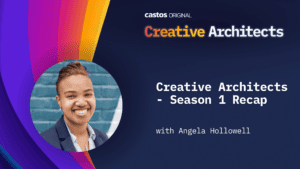Today’s episode is all about saving time as a podcaster, especially a solo podcaster.
Running a podcast resembles running a small business more than you might have guessed…or hoped.
As small business owners, you’re responsible for wearing many hats. If you’ve ever launched a business, you quickly found out that not only are you the owner but you’re also the:
- Head sales person
- Customer support lead
- Accountant
- Janitor
- Food runner
- And the president!
If you’re a solo podcaster, you’re responsible for:
- Producing the content
- Creating the content
- Wrangling logistics like guests and recording time
- Audio engineer
- Marketer and promoter
- Coffee addict (sorry, that’s just me)
Lots there right? Here’s the good news…many of us who are solo podcasters are also small business owners…yay. Wait, I said good news didn’t I?
That means with everything else we have going on how the heck are we going to produce a successful podcast with the limited time that we have? I’ll reveal some of the helpful tools, apps, and theories I’ve leveraged over my career as a podcaster.
By the end of this episode, hopefully you can take a few nuggets of this wisdom away with you.
Hey, by the way, if you’re looking for a great place to start your podcast or maybe you’re bored with your old podcast host — look no further than Castos.com! That’s us, that’s who makes this podcast. We’re building a platform for the podcaster like you, who desire something clean, fast, and powerful for all of your podcast needs. Want to start a podcast network? Check! How about connecting up to your WordPress marketing website? Done! Sell private podcasts or members-only content? You bet!
Learn more about Castos at castos.com or drop us an email [email protected], tell them you heard it here, on the Audience podcast.
Start with the mindset
Please don’t skip past this section, I know you might have rolled your eyes a bit, but I think this is important — especially if you’re a new podcaster. Getting in the right mindset sets the foundation to managing your time as a busy podcaster.
Tip #1: What’s your goal?
We need something to measure, something that gives you feedback that reassures you’re headed down the right path.
I don’t care what it is. It could be downloads, retweets, email subscribers, ad revenue — give yourself something to aim for, which will help you build processes in the future to save time and become more efficient.
P.s. if you’re brand brand brand new, with no goals, I always love to point to growing an email list first. Jump on something like Mailchimp.com to make that process easy.
Tip #2: Develop the plan
I’m a terrible planner. Maybe like you, my super power is just diving into a creative project and…creating.
Starting something new is exhilarating and a chance to show the world something new you’re capable of. Until 3 months from the starting line you’re just clicking the dozens of open tabs in your browser thinking of something new to do.
Have some structure heading into the show like:
- Define a solid show premise to keep you on track
- Outline guests or topics ahead of time
- What’s your go-to market strategy
- When will you measure and reflect on the goals you set
Plans can be complete plans like outlining seasons OR having plans for each episode. I built a career on podcasting not having plans for shows and guests, and while I could fly by the seat of my pants for a while, it catches up to you, I promise.
Even having 3 – 4 bullet points readily available for your show recording will save you from the pitfalls of creating lackluster content.
Tip #3: It’s your show; there are no rules
Guess what? You’re not really competing with anyone else. YOU are your biggest enemy right now.
Not the show you’re trying to mimic or the lavish lifestyle you see your favorite YouTuber living…No, it’s you.
The last tip I have for mindset is to give yourself room to create and learn to love the process. I can guarantee you that once the honeymoon phase of podcasting wears off, you’re going to try to find something else to do. It’s easy to give up on a podcast when there’s so much else to do.
Don’t let your show podfade!
If you set a goal and formulated a plan, you’re on the right track. If time is an issue, don’t do a weekly show. Stick to a twice-monthly schedule, instead. Same advice for promoting and marketing your show. If content creation is all you have time for, cut that in half and spend the other half promoting your show.
If you like to take vacations in the summertime, take a break! Make podcast seasons or dip into your emergency content vault to fill your airwaves.
Bottom line: produce the show however you see fit, to a degree that displaces the chance for burn out from the work ahead.
Tip #4: The power of a pre-interview
You ever remodel a house and say, “We should have just knocked it down and started over, it would have been cheaper.”
That’s how I’ve felt about the dozens and dozens of episodes I’ve published where I wasn’t prepared. And I don’t mean not prepared in the technical sense, but in the good content + knowing who I’m talking to, sense.
There comes a time in the “interview show” podcaster’s life where you start running out of people that you know to be a guest and find yourself in front of people that you don’t have a background on.
Sure they know the premise of the show and their LinkedIn profile looks good, but have you built any rapport in the split seconds after hitting record? Do you know the exact 1 or 2 topics you can punch in to produce quality content? How about tension, the core of great storytelling?
The pre-interview is something I’ve arranged for all the guests I interview on my shows. I spend 10-15 minutes total, really giving them the broad brushstrokes of what I expect out of them as a guest:
- Good sound
- Good lighting
- Good energy
- Give me 1 or two topics you’re GREAT at talking about
- Is there a single takeaway lesson or value for my audience
- Where is the tension? Let the guest elaborate
Being prepared like this is what avoids the “we should have knocked this episode down” feeling after you spend an hour with someone you don’t know barely holding on to a conversation to save your life.
Commit to the pre-interview!
Tip #5: Guest wrangling with the SavvyCal app
Podcasts guests can be like herding cats.
Picking a time to meet, letting them know which tool you’re using to record, mic checks, and head shot photos can all be a bit daunting.
Luckily, there’s a few ways you can tackle this and at the core, at least for me, is a tool called SavvyCal.
SavvyCal lets you connect your calendar or multiple calendars up to a shareable link to give out to your future podcast guests. It automagically connects their availability across timezones to give them the ability to pick a time that works well for the both of you.
Here’s a few ways I use it:
- Separate links for pre-interview vs real interview
- Limit scheduling slots for either type. I.e. I’ll do 3 pre interviews in a week because they are short, but only 1 real interview because they are longer + more energy consuming.
- Auto redirect to a landing page of requirements
What’s that you say, a landing page for requirements?
Another valuable time saving feature would be to have your guest read through your requirements, to reemphasize the importance of a good show or to upload a headshot photo for you to use in the podcast featured image.
This is a massive time saver across pre-interviews, interviews and post show email follow-ups.
Tip #6: Easy recordings + audio quality
If you’re in the early days of your podcast production, maybe you’re using something like Zoom or Skype to record your episodes. And then maybe, you want to start pushing the quality of your audio up a few notches.
Fumbling around with complex audio editing tools does not equal a time saving formula.
So do what I did for a long time, and still do for some podcasts I work on, use a better recording platform to make your episodes sound better without having to do much heavy lifting.
It’s not audio engineering or heavy editing, but I use a platform called Zencastr which will automatically sync up your individual audio tracks and normalize them through their production tool.
You have to pay for it, but it’s a huge time saver to make the show sound somewhat good without having to do a lot of heavy lifting.
Tip #7: Extend your audio editing with Hindenburg or Descript (or both)
I used to spend hours editing a 45 minute minute interview.
The days of using ecamm skype call recorder + adobe audition would send me down an audio engineering rabbit hole that I had no business doing.
Once I started using Zencastr as a competent recording platform, about 6 months ago I shifted to using the Descript audio editing software.
I switched for a few reasons:
- I could edit audio via text, not waveforms
- I could automatically clean up filler words with a push of a button
- It was much easier to create mashups and audiograms
- I could also get a transcription out of it
Descript as a MASSIVE time saver for me. Die hard audio engineers probably won’t use it, but you can export to other DAWs if you’re going to get into the nitty-gritty of audio engineering.
I will say that, at least at the time of this recording, Descript lacks on the audio enhancement tools. Sure it’s got basic EQ and compression, but I never found it all that compelling.
Recently I discovered Hindenburg which has an extremely competent + user friendly interface for recording audio. Now I use Hindenburg to record at the source, at least on solo episodes like this one, and then export to Descript for the bigger chunks of editing.
Adding another _thing_ to a workflow certainly is the opposite of time savings, but it does pay off in a better sounding show in the long run. Plus, less futzing around with making a better quality audio.
Tip #8: Maybe it’s time to spend some money on equipment
Cover your ears if you’re just getting started.
Lots of people ask me about the equipment they should get for their podcast. It’s the glitz and glamour of becoming a podcaster. When in reality, it’s easy work and oftentimes expensive work, depending on what you’re buying.
Newsflash: it doesn’t make your show any better, at least in the important areas like great content + getting it in the earbuds of your audience.
The difference between a $99 Audio Technica ATR-2100x microphone vs a $399 Shure SM7B microphone is only marginally better for most of us.
While the cost is 4 times more expensive, you certainly won’t be able to hear a 4 times better sound. However, great hardware will save you lots of time when you do get to the point of where you want to push the audio quality boundaries.
If you find yourself spending lots of time editing EQ, compression, noisegate, etc in software editing tools, that’s where the great hardware steps in. Record your audio at the highest quality at the source, so you’re not left spending hours on adjustments.
I don’t want to turn this segment into a whole hardware episode, but the devices that do come to mind for time savings beyond a better microphone are:
- Something like a Rode Procaster. It’s a podcast studio in a box, it would take a whole episode to explain, just check it out.
- Fethead or Cloudlifter in-line amplifier. These little but mighty devices really boost the power of a microphone depending on what digital adapter you’re plugged into.
- Universal Audio Arrow Audio Interfce is a very expensive ($499) and complex device that can really dial in better quality audio if you want to spend time with it.
- Streamdeck is a great tool for transitions and controlling livestreams. Like a lot of these items, it’s not earth shattering, but can add a nice bump to your production quality if you stream your shows.
Tip #9: Automation
This isn’t a one size fits all solution. Automation can come in many different forms and tools, which largely will depend on your aptitude for these things and where you’re at with your podcast.
I’m going to break it down into 3 different sub categories:
- Automation for workflow via Zapier
- Social media promotion via Buffer
- Email notification + promotion via Mailchimp
Another caveat is, none of these tools are set in stone. All 3 have alternatives you can seek out or pair up with. The following concepts are just what I’ve used before.
Zapier
Zapier is like the glue for apps across the web. Want to send a file from Dropbox to Auphonic for audio processing? You can do it. Take your WordPress blog post and drop it into a shared Airtable database for collaboration? Easy peasy.
Zapier can automate a lot of things in your podcast based on triggers. Someone books a Savvycal time with you, automatically have Zapier set up a Zencastr room + fire off a welcome email to them.
Your creativity (and the apps they support) are the limits.
Buffer
I love Buffer to schedule all of my Twitter or LinkedIn promo items. I love the simplicity of it, coupled with the calendar view. There is something familiar about seeing all of my work in a 30-day view that I’m comfortable with.
If you’re busy like the rest of us, maybe getting to tweets early morning or on the weekends isn’t going to fly. Or maybe you want to queue up 10-15 posts based on 1 episode you publish, make your life easier using something like Buffer.
Mailchimp
Email automation can be the king of delivering your past valuable content. Like Zapier, your creativity is the limit here. But if you’re pushing your listeners to join an email list as part of your call to action, why not send out an automated series of emails that helps with repurposing your favorite podcast episodes.
Get someone hooked immediately on past content that was amazing and get them sharing to resurface these episodes to increase awareness.
Marketing + promotion on auto-pilot. I love it!
Tip #10: Outsource it!
Okay, okay, I know this is a bit of a cheesy #10, but hear me out: If your podcast is earning a living, through ads or a service based ROI, get the busy work off of your plate!
Look at your podcast in quarters:
- ¼: Planning, research, outreach, logistics
- ¼: Content creation (recording, streaming, filming, etc)
- ¼: Editing and producing clips
- ¼: Promoting
If you could outsource 25-50% of the work you don’t want to do, think about how much that clears your mind (and your plate!) to make the other components that much better.
Grab someone from your team, a friend, a freelancer or hey (shameless self promotion) if you want an experienced & professional team to do it, hire us at Castos! We have an award winning production team waiting to help take the busy work of podcasting off your plate. Learn more at Castos.com/services
Conclusion
A successful podcast takes a lot of work.
Lots of moving parts and lots to do to get it top of mind with our Audience. Take it one step at a time and don’t give up! The hidden benefits of podcasting are yet to be discovered!
If you enjoyed today’s episode, just go on Twitter and share it with others. If you’re listening in a pdocast app hit the share button and post it to your favorite social media channel. If you’re listening in a Podcast 2.0 app…well, we don’t get streaming satoshis here, I’m sorry.
The best value for us is to check out Castos.com if you’re looking for a new podcast host and leave us a review on Podchaser.com. Search for Audience on podchaser.com and rate us, we’d appreciate it.
Okay, I’m Matt and I’m done for today! See you in the next episode.



